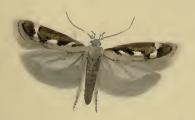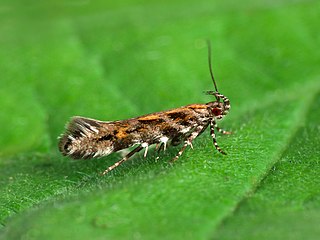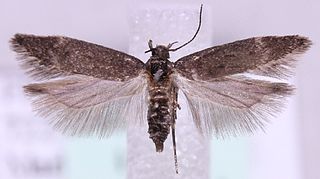
Bryotropha is a genus of the twirler moth family (Gelechiidae). Among these, it is placed in the tribe Anomologini of subfamily Gelechiinae; the tribe was formerly considered a distinct subfamily Anomologinae.

Athrips mouffetella is a moth of the family Gelechiidae. It is found from central and northern Europe to the Ural Mountains, Siberia and the Russian Far East. It has also been recorded from North America.

Acompsia cinerella, the ash-coloured sober, is a small lepidopteran species of the twirler moth family (Gelechiidae). It is the type species of the genus Acompsia, once assigned to the subfamily Anacampsinae but generally placed in the Dichomeridinae. The species was first described by Carl Alexander Clerck in 1759.

Carpatolechia proximella is a moth of the family Gelechiidae. It is found in most of Europe, Turkey, the Caucasus, Central Asia and Siberia.

Caryocolum fraternella is a moth of the family Gelechiidae. It is found in Ireland, Great Britain, Fennoscandia, Denmark, Germany, the Netherlands, France, Switzerland, Spain, Latvia, Estonia and Ukraine.

Caryocolum marmorea is a moth of the family Gelechiidae. It is found from Scandinavia to the Mediterranean islands, and from Ireland to Poland, Hungary and Greece. It is also found on the Canary Islands and Madeira. It is also found in North America.

Aristotelia ericinella is a moth of the family Gelechiidae. It is found in most of Europe, except most of the Balkan Peninsula.

Aproaerema anthyllidella is a moth of the family Gelechiidae. It is found in most of Europe, Kyrgyzstan, Iran and North America.

Apodia bifractella is a moth of the family Gelechiidae. It is found in most of Europe, as well as Turkey, the Caucasus and North Africa.

Bryotropha domestica is a moth of the family Gelechiidae. It is found from Ireland to Germany, Slovakia, Romania and Bulgaria and from the Benelux to the Iberian Peninsula, Sicily, Crete and Cyprus. It is also found in Morocco, Algeria, Tunisia, Libya, the Middle East, Turkmenistan, Saudi Arabia and Yemen.

Bryotropha affinis is a moth of the family Gelechiidae. It is found in most of Europe.

Athrips tetrapunctella is a moth of the family Gelechiidae. It is found in France, Great Britain, Ireland, Fennoscandia, Denmark, Estonia, Latvia, Russia and Ukraine. In the east, the range extends through the southern Ural and Siberia to Primorsky Krai.

Bryotropha politella is a moth of the family Gelechiidae. It is found in Ireland, England, Scotland and the Massif Central in France.

Bryotropha desertella is a moth of the family Gelechiidae. It is found in most of Europe, North Africa (Morocco), Turkey, Turkmenistan and the Russian Far East.

Bryotropha umbrosella is a moth of the family Gelechiidae. It is found in open dune areas throughout most of north-western Europe. In southern Europe, it is only known from one record from Spain.

Bryotropha similis is a moth of the family Gelechiidae. It has a Holarctic distribution, including Greenland and Iceland. It is widespread in northern, central and eastern Europe. In southern Europe, it is only known from a few mountainous regions. It is also found throughout the Palaearctic.

Bryotropha senectella is a moth of the family Gelechiidae. It is found throughout Europe.
Monochroa suffusella, the notch wing neb, is a moth of the family Gelechiidae. It is found from Fennoscandia to the Pyrenees and Alps and from Ireland to Romania. In the east, the range extends to Japan. The habitat consists of bogs, fens, swamps and salt-marshes.

Carpatolechia fugitivella, the elm groundling, is a moth of the family Gelechiidae. It is found in almost all of Europe, Turkey, the Caucasus, Mongolia, southern Siberia, the Russian Far East and Korea. It is also found in Canada, where it has been recorded from Ontario and Quebec. The habitat consists of woodland, parks, gardens and hedgerows.

Carpatolechia notatella, the sallow-leaf groundling, is a moth of the family Gelechiidae. It is found in most of Europe and Turkey.


















